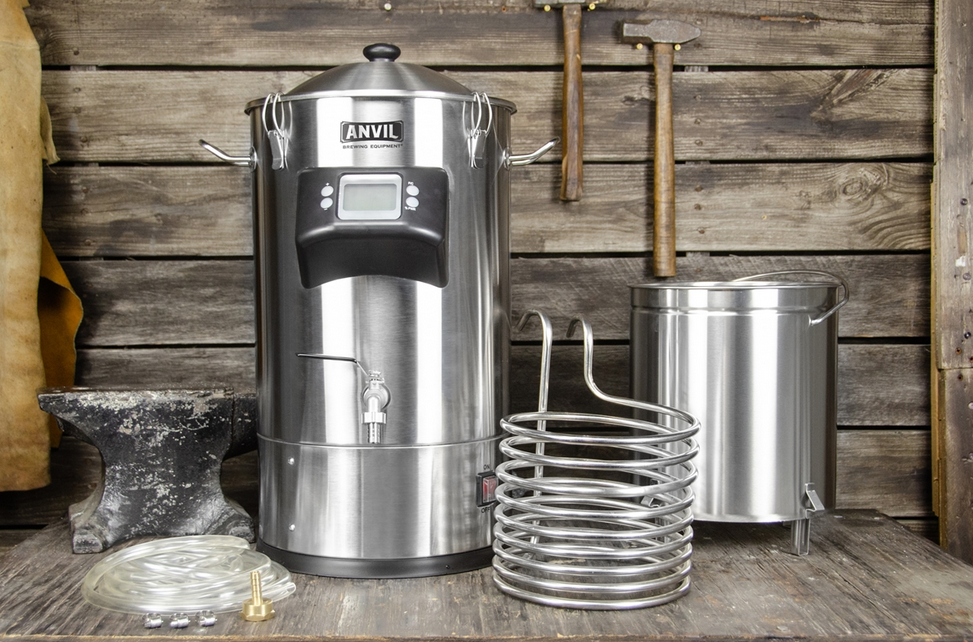With the growing popularity of small tabletop all-grain brewing systems I decided to take a look this week at how to set up and use these systems in BeerSmith.
Tabletop All-in-one Brewing Systems
There has been an explosion in the popularity of small all-in-one all grain electric brewing systems. These include systems like the DigiMash, Braumeister, Grainfather, Brewzilla, and Anvil Foundry. The popularity has been driven by their low cost, compact size, ease of use and versatility. I did a full length podcast covering the major systems available in 2020 with Chris Graham, which is a useful resource if you are looking for a system.
The common elements to these systems include a large stainless steel electric-heated vessel, some kind of basket for containing the grains, and optionally a pump to recirculate the wort. Some systems also have digital control and various degrees of automation. Together these act like a traditional Brew-in-a-bag (BIAB) system.
In operation you typically heat the mash water in the vessel and then mix in the grains to start the mash. For systems with pumps, you can recirculate the wort to maintain a constant temperature while mashing. When the mash is complete you slowly remove the basket containing the grains, and then heat the wort to a boil. Then you continue with the boil, add hops and chill and ferment your beer much like any other system.
Setting Up Your Equipment Profile in BeerSmith
If you have a popular tabletop brewing system, you can in most cases find a good BeerSmith equipment profile with our add-ons or preloaded equipment feature. Most of the popular systems can be found on the desktop version of BeerSmith using the File->Addons command to download the profile. On the web version you can go to Profiles->Equipment and click on Manage Preloaded to download preloaded equipment profiles.
If you have a new or unique system you can also create your own equipment profile. I previously published an article that walks through the important fields when creating a BIAB equipment profile in BeerSmith. Using the equipment profile wizard as described in that article works fairly well when building a profile. You start with the “into fermenter” volume and then work back including the trub losses and boil losses to get the proper volumes at each stage.
Building Your Recipe
Once you have an equipment profile you can use it to start building your recipe. I have a number of tutorials on how to build a recipe in BeerSmith here, but the basic process is to click on Add Recipe and then select your equipment profile. After that you can begin adding ingredients and select the style you want to build up your beer.
Mash Profiles
A consideration when working with these systems is which mash profile to use. Most brewers treat their all-in-one systems as traditional Brew-in-a-bag (BIAB) style systems. This means they add all of the water needed for the brew at the very beginning of the mash and keep it in the vessel the entire time. This has the advantage of not needing to add water later, but also means you are mashing at a higher water/grain ratio than many other brewing systems.
To use a traditional BIAB mash in BeerSmith, all you need to do is select any of the BIAB mash profiles that come with BeerSmith within your recipe. BeerSmith will then calculate the temperature of water needed before you mash in and calculate the total water needed and show this on the brew steps sheet you can easily print when you brew.
While a BIAB mash covers 95% of these systems, there is also the option to do a more traditional mash profile especially if you have a system with a pump. For example you may want to specifically mash in at a lower water/grain ratio or support multi-step mashes. You can use any of the mash profiles within BeerSmith, but some considerations come into play. For example if you don’t include the water up front in the mash, you will now need to heat your sparge water in a separate vessel and then introduce it in the system before you remove the grains.
If doing a multi-step mash you need to also consider how to heat the mash. Multi-step mashing works best if you have a re circulation pump to avoid hot-spots in the mash. You can add “temperature” mash steps to your BIAB mash profile if you want a multi-step mash as these temperature steps effectively mean you are applying direct heat to the mash which is the case with the pump-equipped systems.
Another general consideration when working with these systems is total mash volume. Though most systems are generously sized, when making very high gravity beers you can run into limits. A high gravity beer will not only achieve lower mash and brewhouse efficiency, but the grains simply take a lot of space. I recommend checking the Mash tab for the Mash Volume Needed field to make sure it is not larger than your vessel size if brewing a high gravity beer.
I hope you enjoyed this article on using all-in-one systems with BeerSmith. Thanks for joining me on the BeerSmith Home Brewing Blog. Be sure to sign up for my newsletter or my podcast (also on itunes…and youtube) for more great tips on homebrewing.
